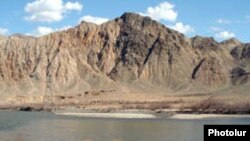Movsisian said he and his Iranian counterpart Majid Namju will inaugurate the start of construction work on the Arax river separating the two countries immediately after signing a relevant agreement in Yerevan.
The dates of Namju’s upcoming visit to Armenia are still being “clarified,” he said. Other officials told RFE/RL’s Armenian service that the Iranian energy minister will likely arrive before the end of this month.
The Armenian government formally approved the agreement and authorized Movsisian to sign it at a meeting earlier in the day. Prime Minister Tigran hailed the impending launch of the “important” commercial project that will give a major boost to Armenian-Iranian commercial ties.
The agreement envisages that the two power plants will be built on either side of the Armenian-Iranian border and have a capacity of 130 megawatts each. They both are to be built by an Iranian company, Farad-Sepasad, in the next five years.
According to Movsisian, Armenia will finance its share of the project, which he estimated at $323 million, with future electricity supplies to Iran. “The Iranians will build, exploit the facility [located on the Armenian side of the border] and recoup their investments with electricity to be generated there,” he told RFE/RL’s Armenian service.
“We need will 15 years to pay back the [Iranian] investments with electricity supplies,” he said, adding that the plant will then become property of Armenia.
“This is going to be a cascade [of two hydro-electric stations] whose first facility will be located in Armenia,” explained Movsisian. “That is, water will first flow to and be used on the Armenian side and only then reach to the Iranian plant.”
Energy has been the focal point of Armenian-Iranian economic cooperation. It gained momentum in late 2008 with the inauguration of a natural gas pipeline connecting the two countries. Armenia began receiving modest amounts of Iranian gas through that pipeline in May last year. The volume of those deliveries is expected to soar in the next few years.
Movsisian said in July that the planned construction of a third high-voltage transmission line connecting the Armenian and Iranian power grids and another Armenian-Iranian fuel pipeline will also get underway by the end of this year. The minister did not comment on these projects on Thursday.





